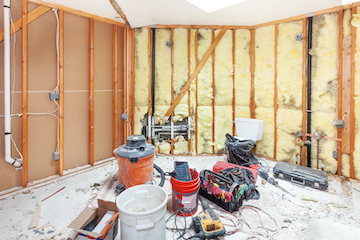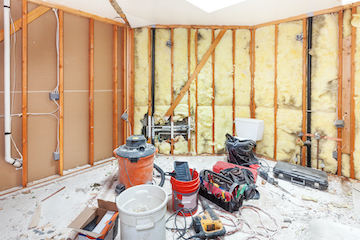

While it’s understandable that one may buy into the myth that renovation equals renewal in terms of your home’s health, the fact of the matter is that the very remodeling process you believe to be your saving grace may, in truth, be another avenue for polluting your indoor air quality further.
Now, we aren’t saying that you shouldn’t move forward with whatever plans you have to manifest your dreams and makeover your home.
But we are saying that you should be aware of what processes are primed for introducing pollution, and thus you should also consider how best to mitigate the potential long-term effects your remodeling may leave on your home’s air quality.
The Rundown On Renovations
“Construction and renovation projects present a variety of situations which may release contaminants and pollutants that can impact the indoor air quality (IAQ) of a building,” according to a study released by Boston College. “These contaminants may be transported to other areas via the heating, ventilation and air conditioning systems and subsequently affect populations beyond the immediate project area”
To put it simply, the renovation or remodeling process of the home may make your property susceptible to indoor air pollution in more ways than one.
Between degraded ventilation, the introduction of increased volatile organic compounds (VOCs), and the dispersion of other particulate matter, you’ll want to restrict the airflow of certain rooms while renovations are underway or otherwise find ways of purifying said areas until you’re sure the collateral pollution will not spread further.
Moreover, the Centers for Disease Control (CDC) specifies that renovation projects are also liable to release other contaminates — namely that of biological origin — into the air.
Products and Pollution
Volatile organic compounds, or organic chemicals that have a high vapor pressure and may contain hazardous contaminants when airborne, are one of the biggest culprits when it comes to remodeling-related pollution.
“VOCs can be emitted into indoor air from a variety of sources, such as building materials, flooring, composite wood products, and adhesives,” as explained in an article published by Occupational Health and Safety Online. “Adhesives used during flooring installation, for example, can represent a significant source of VOC emissions into the air.”
And one of the most commonly found sources of VOC emissions? Paint.
Not only do most paints give off volatile organic compounds, but the Environmental Protection Agency (EPA) also specifies that the painting process in and of itself may pollute the air — such as when one sands down a wall or other surface prior to painting — as this further disperses dust and other fine particles.
How The Outside Comes In
When renovating your home, it’s not only what you can immediately control that needs to be taken into consideration. While the airflow inside of the property needs to be accounted for, what about the outdoor airflow?
According to the EPA, “homes that are designed and constructed to minimize the amount of outdoor air that can ‘leak’ into and out of the home may have higher pollutant levels than other homes.”
The exception to this is homes that have some form of mechanical ventilation.
Additionally, moisture intrusion can add another layer of complexity when it comes to isolating, containing, and preventing microbial or biological contaminants in the air.
If the home in question has already had an issue of “chronic dampness,” as warned by the CDC, the remodeling process may unearth and disseminate underlying mold, bacteria, and other moisture-loving microbes that have resided beneath the surface, unbeknownst to the home’s residents.
Taking The Next Step
If you’re unsure of how best to maintain your home’s indoor air quality both during and after your remodeling process, it’s wise to reach out for help.
Particularly if you are worried that you may have a hazardous intrusion of VOCs, moisture, or other airborne contaminants, it’s time to contact Luce Air Quality! We are your team of local indoor environmental experts, and we stand at the ready to help you optimize your indoor air quality. Call us today at (904) 803-1014 to schedule your investigation!


